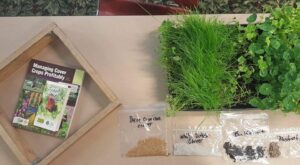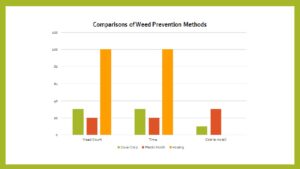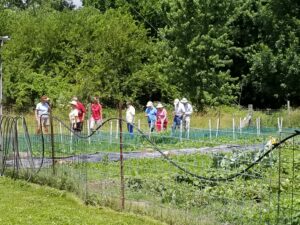Final report for FNC17-1073
Project Information
We own an 11-acre multi-enterprise vegetable farm in Central Indiana. With one half acre under tillage producing over 35 varieties of fruits and vegetables, we use intensive spacing in our market garden with succession planting of additional product. We started the business in 2016, but expanded in earnest to support 15 CSAs and two local farmers' markets in 2017. A family operation, I do most of the work myself. In the past seven years of homesteading we've avoided the use of chemicals. We seek to use low-till or no-till methods, and have been successful over the last three years. We have used winter cover drops (mixture of oats, daikon radish, and crimson clover) for four years, which has produced a very nice, fertile soil. Pleased with these results, we seek to determine if interseeded cover crops will further benefit our operation.
Problem addressed: Find and implement an effective, economical solution for weed prevention in the small, chemical-free vegetable market garden operation.
As a small farmer, it is critical I implement the most effective sustainable agricultural practices. I operate my business alone, hiring resources only at critical harvest points and for marketing. Weed prevention and management is my highest concern due to the adverse impact weeds have on plant production and health, the resource hours required to prevent or remove weeds, and the resulting effect on the quality of life of the farmer. I must solve this problem to sustain my business.
This problem presents a dilemma for farmers I've talked to in my community, and I can assume that is true for many others. The desire to avoid chemical herbicides and put soil health at the forefront has resulted in a reluctance to follow traditional practices. I've toured vegetable gardens wrought with weeds affecting yields.
Solution pursued: Compare the effectiveness of three varieties of interseeded cover crops in weed prevention with two commonly used methods in similar market garden operations. The cover crop solution will be compared to plastic or biodegradable mulch, and manual hoeing.
Research Approach: Each chosen variety of vegetable will be planted in 20 foot test strips, each utilizing a different method of weed control. I worked with Purdue Extension and NRCS and did my own research to determine which specific cover crop varieties to test. I planned to test a minimum of three different vegetable crops, and ended up testing five.
Test cases:
- Green Pepper - Buckwheat terminated prior to going to seed, Paper mulch, manual hoeing.
- Tomato - Crimson Clover, red plastic mulch, manual hoeing.
- Broccoli - Crimson Clover, manual hoeing
- Summer Squash - Icicle radishes, Nasturtiums, manual hoeing
- Storage Onion - Crimson Clover, paper mulch, manual hoeing
Ancillary research - I planted white clover in aisles to suppress weeds.
For each case I tracked resource man-hours to install, weed plug counts per square foot, man-hours to manage weeds, and soil health. Soil health was assessed through soil testing.
Education: Two field days were held and I presented the project and results at a community training session and a Boone County Master Gardener meeting.
Field Days: The Boone County Master Gardeners combined with NRCS, and Soil and Water Conservation District had 28 attendees. The Lebanon High School FFA group had 12 student attendees.
I developed and used a Powerpoint presentation to deliver information to over 60 attending the two meetings.
Through this project I have learned that interseeded cover crops can help prevent weeds in a chemical free vegetable market garden operation. The effectiveness of the cover crop varies by specific vegetable, and must be combined with other weed prevention methods for the best overall solution.
In summary:
- Green Pepper - Buckwheat is not effective because of the rate of growth. Plastic mulch is a better alternative.
- Tomato - Likewise, due to long growing season, we recommend the use of plastic mulch or early seeding of crimson clover.
- Broccoli - Crimson Clover is a good cover crop to use with this vegetable.
- Summer Squash - Icicle radish (multiple plantings) and marigolds for pests are recommended.
- Storage Onion - Plastic mulch for the onions is our recommendation.
White clover planted in the aisles is highly recommended and a great nitrogen source.
As far as time, the cost of hoeing far exceeds the time/cost to purchase or install the plastic mulch or plant cover crop.
Objectives:
- Track and compare the overall costs for each solution.
- Test and compare impacts to the soil of each solution at specific intervals.
- Conduct field days and share the research status and opportunity.
- Arrive on a working solution for weed prevention in my market garden.
- Document said solution.
Short term goals:
- Compare and contrast man-hours to implement and maintain each solution.
- Compare and contrast weed starts per square foot at multiple time intervals.
- Compare and contrast man-hours to remove weeds at multiple intervals.
Cooperators
Research
One of the most involved aspects of the process was the choice of cover crops to interseed with vegetable production crops. It seems not all cover crops are created equal. It is crucial to choose them wisely, as some may impact production. I worked with Purdue Extension and NRCS, but I also reviewed SARE materials.
The cover crops are seeded one third of the way through the growth cycle of the vegetable. This is to eliminate competition for resources. Even then, the nutrient needs of the cover crop must be compared to that of the vegetable. In most cases, I was able to seed the cover crop as I transplanted my seedlings.
Cereal rye and broadleaves cover crops have an allelopathic effect and so will not support seeds germination. Since my goal was to seed a third of the way through the growth cycle of my vegetables, this was a benefit and not a concern.
The cover crop may provide nutrients. The best example of this is the white clover seeded in the aisles traps nitrogen from the air developing a sort of fertilizer that can be used by the companion plant.
Plastic mulch can be problematic for some plants due to heat retention. So, that is not a good solution for cold crops, unless applied very early in the season.
My first step was to take soil samples. I wanted to determine if the use of cover crop improved the soil. More about this in the results and discussion session. I used A&L Greatlakes Laboratories.
I then planted the cover crop or installed the plastic mulch where planned. I left the bare soil around plants in the areas to hoe. I planted 20 foot sections using the various defined combination of methods.
I used the Jang seeder to plant the cover crop seed. The use of this precision seeder was critical as I wanted to ensure the cover crops were uniformly planted providing that much needed coverage while avoiding clumping and thinning of that intervention.
Each time I removed weeds, I used a 1" x 1" box to count weed starts or plugs. I charted these results, counting in each of the test case areas at the same time. Then I went about my work to remove the weeds. Here is a picture of the box I used on the left. This display was used at a cover crop class I presented, so you can see cover crops seeds and growing varieties of crops on the right.

I tracked weed count and time to remove weeds on a chart throughout the season, noting empirical observations. I then aggregated the data to draw my conclusions and present my results.
Soil samples were again gathered and sent for analysis to allow me to assess impacts to soil health.
Conclusion: There is value to use of interseeded cover crops as a method of weed prevention.
This chart provides data to use when comparing weed control methods. The most significant finding is weed count of bare soil (hoeing) far exceeds that of the cover crop or plastic mulch. That is a significant finding, as the cost for removal of weeds is my highest concern.

The cost to install the cover crop or plastic mulch solutions was very low as compared to the benefits.
In some cases, it was difficult to get good results from using the cover crop. For example, buckwheat interseeded with green peppers quickly grew larger than the peppers. Because it is important to remove the buckwheat as it begins to flower, there was little benefit to using this short-lived crop in the longer growing and lasting peppers.
We tried to use paper mulch in the onions. My thought was the biodegradability of the paper would be a benefit and avoid potential chemicals leaching from plastic into the ground. The first big rain destroyed the paper so I do not plan to use it again.
I achieved some soil improvements through the use of cover crops. The soil test results appear below.
In summary:
- I expected improvements in organic matter. Only the tomato patch showed a small improvement. Organic matter is slow to improve, so I plan to use winter cover crops and retest in the spring.
- Almost all garden areas where I planted cover crops showed an increase in potassium (K) and a decrease in salts.
- The most improved soil was in the Broccoli bed, which was sown with crimson clover. In this case, phosphorus and potassium improved, and the Cation Exchange Capacity, meq/100g went from 13 to 12.4. Although we want this in a range of 5 to 15 for loamy soils, this small decrease can improve productivity.
- The tomatoes (with crimson clover) showed a small increase in organic matter (the only one in the garden) and an increase in potassium and sulfur.
- The best news is the soil test resulted in fewer recommended amendments for the green peppers and broccoli. This means reduced costs for the farmer and potentially increased yield.
Educational & Outreach Activities
Participation Summary:

I held a field day for the Boone County Master Gardeners on June 19, 2017. The members were invited to the farm to hear about the grant and see progress to date. We clearly marked the various garden beds involved in this research. I provided an overview to the group and circulated, answering questions. The Purdue Extension Ag Educator and the NRCS and Soil and Water Conservation District representatives were involved to help guide participants and answer questions. We had 28 attend. Lunch was served as part of this day.

The summer program for the local FFA group involves a series of field trips. I worked with the Ag teacher at Lebanon High School to include our farm as one of the tour sites. The students visited the farm on June 28, 2017. They arrived in a bus. We provided an overview of the grant and then took them on a tour of the farm. Again, the various vegetable beds involved in the project were clearly marked, and each was discussed. The students seemed appreciative of this opportunity and the teacher mentioned she was pleased. We had 10 students and the teacher attend.
On Tuesday, September 5 I was invited to participate in a "Using Cover Crops in Home Gardens" presentation at our local library. Curt Emanuel, Purdue Extension Boone County, Indiana presented the concept of cover crops and asked me to share my real-world experience interseeding cover crops for proactive weed prevention. There were 20 attendees and I fielded many questions after the presentation. I did an informal poll to see how many might use cover crops for this purpose in their garden, and seven answered they would.
I used this same community presentation to present the program at the Boone County Master Gardeners' meeting on September 18, 2017. There were 47 members present at the meeting. Again, I did an information poll to see who would be interested in using cover crops in their home gardens, and over 15 answered yes. This was a 30 minute presentation.
Learning Outcomes
There were clear advantages to using the cover crops in weed prevention, but some applications were more successful than others.
There were two very successful cover crop interventions -- Icicle Radish interseeded with summer squash and white clover seeded in garden aisles. These were both effective in weed prevention and easy to install. We were not impressed with the paper mulch we tested because it was destroyed by the weather within two weeks. The plastic mulch was more effective, but not feasible for some varieties as it retains heat.
Overall Recommendations:
- Plant white clover in the aisles of your garden. This crop fixed nitrogen and provided a clean pathway to work in. We were initially worried it would "take over", but this was not the case. It was very controllable.
- We recommend crimson clover interseeded with broccoli plants. The weed control was effective and the soil improved.
- Plastic mulch was the most effective method of weed control for green peppers, storage onions, and tomatoes. With a long growth season, the cover crops, while effective for a short time, did not provide weed prevention for the season.
- Icicle radishes proved to be a highly effective method of weed control for the summer squash. We tried nasturtiums for pest control, but plan to go back to marigolds. The radishes may need to be seeded twice, as they should be pulled as they reach bloom.
We partially overcame our identified barrier through the interventions above. Some relief from weeding was realized, but not everything we tried was effective. We look forward to next year when we'll increase use of the methods we found to be most effective for each specific vegetable. This field of research shows a lot of promise. We are just beginning to understand the many uses of cover crops.